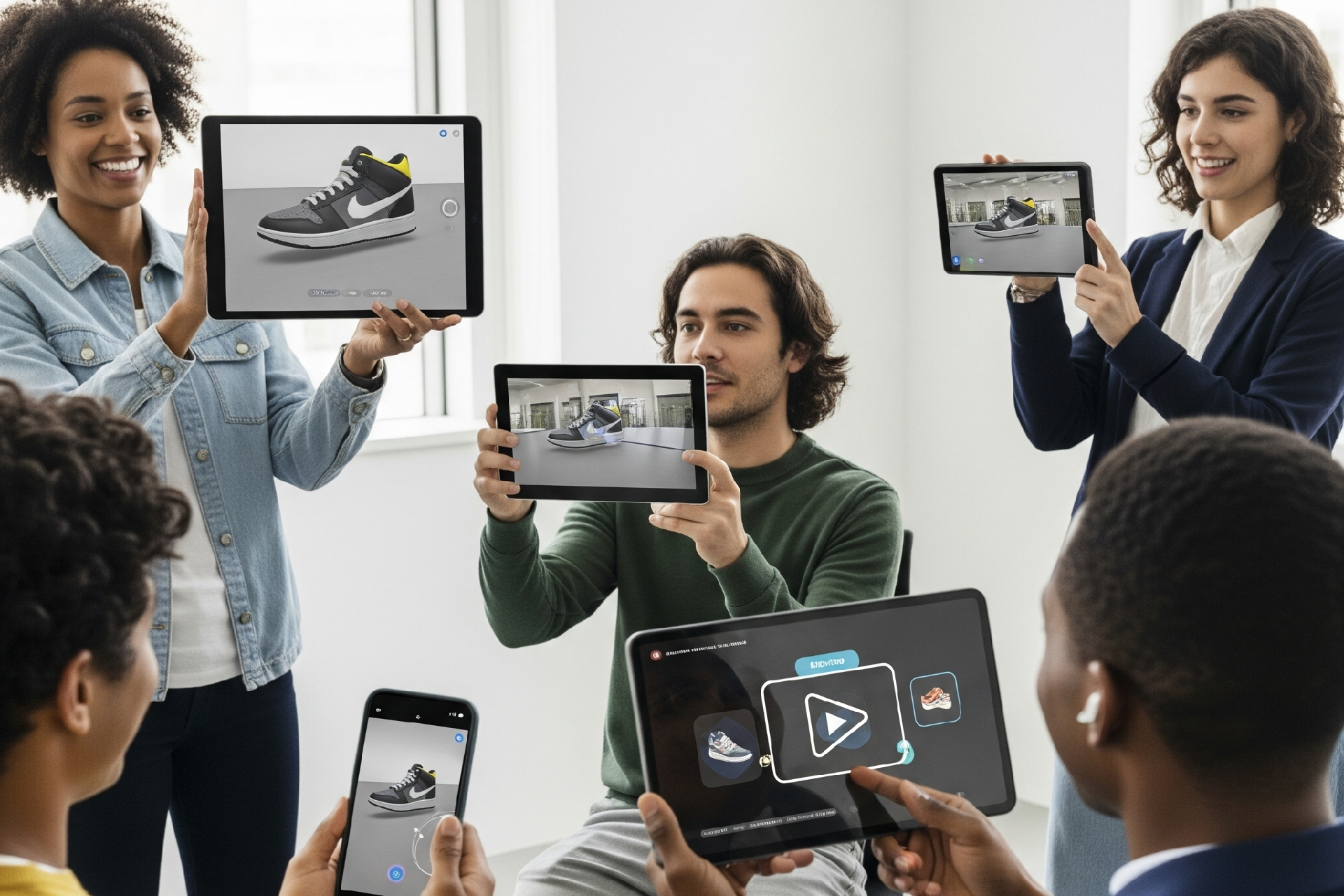
How Brands Are Using AR and Interactive Video to Transform Campaigns in 2025
In a digital age defined by short attention spans and ever-evolving technology, brands are constantly seeking innovative ways to captivate audiences and drive deeper engagement. Among the most transformative trends shaping the future of creative campaigns are Interactive Video and Augmented Reality (AR). These immersive technologies are not just fleeting novelties, they’re redefining storytelling, brand experience, and user engagement across industries. As we look toward the future of marketing all over the world, integrating interactive video and AR into campaigns is no longer a luxury, it’s a necessity.
What Are Interactive Videos and Augmented Reality?
Interactive Video is a form of digital video that supports user interaction. Rather than passively watching a video, viewers can click, swipe, or make decisions that influence the content they see. This dynamic form of storytelling empowers users to become active participants, dramatically increasing engagement and retention.
Augmented Reality (AR) enhances the real world by overlaying digital content such as images, videos, or animations on a user’s view through a smartphone, tablet, or AR glasses. Unlike virtual reality, which creates an entirely simulated environment, AR blends the digital with the physical, offering seamless integration into everyday life.
Why Are These Technologies Crucial for Creative Campaigns?
- Enhanced Engagement: Users spend significantly more time with interactive content. Studies show that interactive videos can increase viewing time by up to 47% compared to traditional video.
- Higher Conversion Rates: Interactive and AR-based campaigns tend to have higher conversion rates due to increased user involvement. Personalized pathways in interactive videos or immersive product demos in AR reduce decision fatigue and encourage action.
- Immersive Storytelling: With AR and interactive videos, brands can tell multi-dimensional stories that foster emotional connections, deepening brand loyalty.
- Data Collection: Interactive campaigns allow for real-time data collection on user preferences, choices, and behaviors, enabling better personalization and ROI tracking.
- Social Sharing and Virality: Experiences that are fun, shareable, and unique are more likely to be spread across social media, amplifying reach organically.
Real-World Applications
- Retail and E-Commerce
Imagine a customer pointing their phone at a sneaker and seeing how it looks in 3D from every angle, or clicking a video to customize its color, size, and price. Brands like Nike and IKEA are already using AR and interactive video to revolutionize the shopping experience.
- Education and Training
Interactive video quizzes, choose-your-path scenarios, and AR simulations provide hands-on learning. This method is proving highly effective in corporate training and educational sectors.
- Healthcare
AR is used to help patients understand procedures through visual simulations, while interactive videos guide them through post-op recovery. This enhances patient engagement and trust.
- Entertainment and Media
Netflix and other platforms are experimenting with choose-your-own-adventure narratives. Meanwhile, AR filters and effects are engaging younger audiences across TikTok, Instagram, and Snapchat.
- Real Estate and Architecture
Virtual tours are evolving. AR enables potential buyers to visualize furniture in a space, while interactive videos guide them through customized property journeys.
Optimization for Voice and Visual Search
As users increasingly rely on voice assistants like Siri, Alexa, and Google Assistant, optimizing content for voice search is critical. Likewise, visual search where users search via images instead of text is gaining traction. Here’s how to future-proof your interactive and AR content:
Voice Search Optimization
- Use natural language and conversational tone in scripts and content.
- Incorporate long-tail keywords and question-based phrases (e.g., “What is interactive video marketing?”).
- Ensure your content loads quickly and is mobile-friendly.
- Include structured data and schema markup for enhanced voice search visibility.
Visual Search Optimization
- Tag all images and AR content with relevant alt text.
- Use descriptive file names and metadata.
- Implement image sitemaps for better indexing by search engines.
- Leverage rich media formats that are compatible with platforms like Google Lens.
The Role of Interactive Video & AR in the U.S. Market
The United States remains a global leader in the adoption of digital marketing technologies. With over 290 million smartphone users, high-speed internet, and a tech-savvy population, the U.S. is fertile ground for innovative campaigns. American consumers expect brand experiences to be intuitive, personalized, and immersive.
A 2024 report by Statista found that over 70% of U.S. Gen Z and Millennial consumers engage with AR filters monthly. Meanwhile, interactive video usage among marketers rose by 32% year-over-year. These statistics signal a clear message: brands that fail to adopt these technologies risk falling behind.
Case Study: Burger King’s Interactive Campaign
Burger King’s “Whopper Detour” campaign used interactive video and AR geo-targeting to offer customers a 1-cent Whopper if they ordered near a McDonald’s location. The campaign was a viral hit, generating over 1.5 million app downloads and skyrocketing user engagement. This clever use of gamification, interactivity, and location-based AR is a blueprint for modern campaign success.
Challenges and Considerations
While the potential is vast, brands must also consider:
- Cost of Production: High-quality interactive and AR content requires investment in tools, talent, and testing.
- User Experience (UX): A seamless experience is crucial. Poor UX can lead to frustration and disengagement.
- Cross-Platform Compatibility: Ensure content works across multiple devices and browsers.
- Privacy & Data Security: With interactivity comes data, ensure compliance with GDPR, CCPA, and other regulations.
Tools and Platforms to Get Started
- ZapWorks: Ideal for building AR experiences without coding.
- Adventr: Create interactive videos with branching paths.
- 8thWall: Powerful AR development platform for web-based experiences.
- Adobe Aero: For designing immersive AR environments.
- Vimeo Interactive: Great for brands venturing into interactive storytelling.
Future Trends to Watch
- AI-Driven Personalization: Integrating AI with interactive and AR content to serve real-time tailored experiences.
- AR Glasses and Wearables: With products like Apple Vision Pro on the horizon, wearable AR will redefine user interfaces.
- Shoppable AR and Video: Seamless shopping directly within AR scenes or interactive videos.
- Mixed Reality Campaigns: Merging AR, VR, and physical spaces for ultra-immersive experiences.
- Zero UI Interfaces: Voice and gesture controls will minimize the need for traditional navigation.
Final Thoughts
Interactive Video and Augmented Reality are not just tools, they’re transformational forces in modern marketing. As consumers demand richer, more engaging content, brands that embrace these technologies will stand out, build loyalty, and drive results.
If your brand is ready to step into the future, Apical Creative Hub is here to help. We specialize in crafting cutting-edge digital experiences that not only dazzle but deliver measurable ROI.
Ready to Elevate Your Campaigns?
Let’s turn your vision into an immersive experience.
Contact Apical Creative Hub Today
Follow us on Instagram LinkedIn and Facebook
Stay ahead with our newsletter – Sign up here




